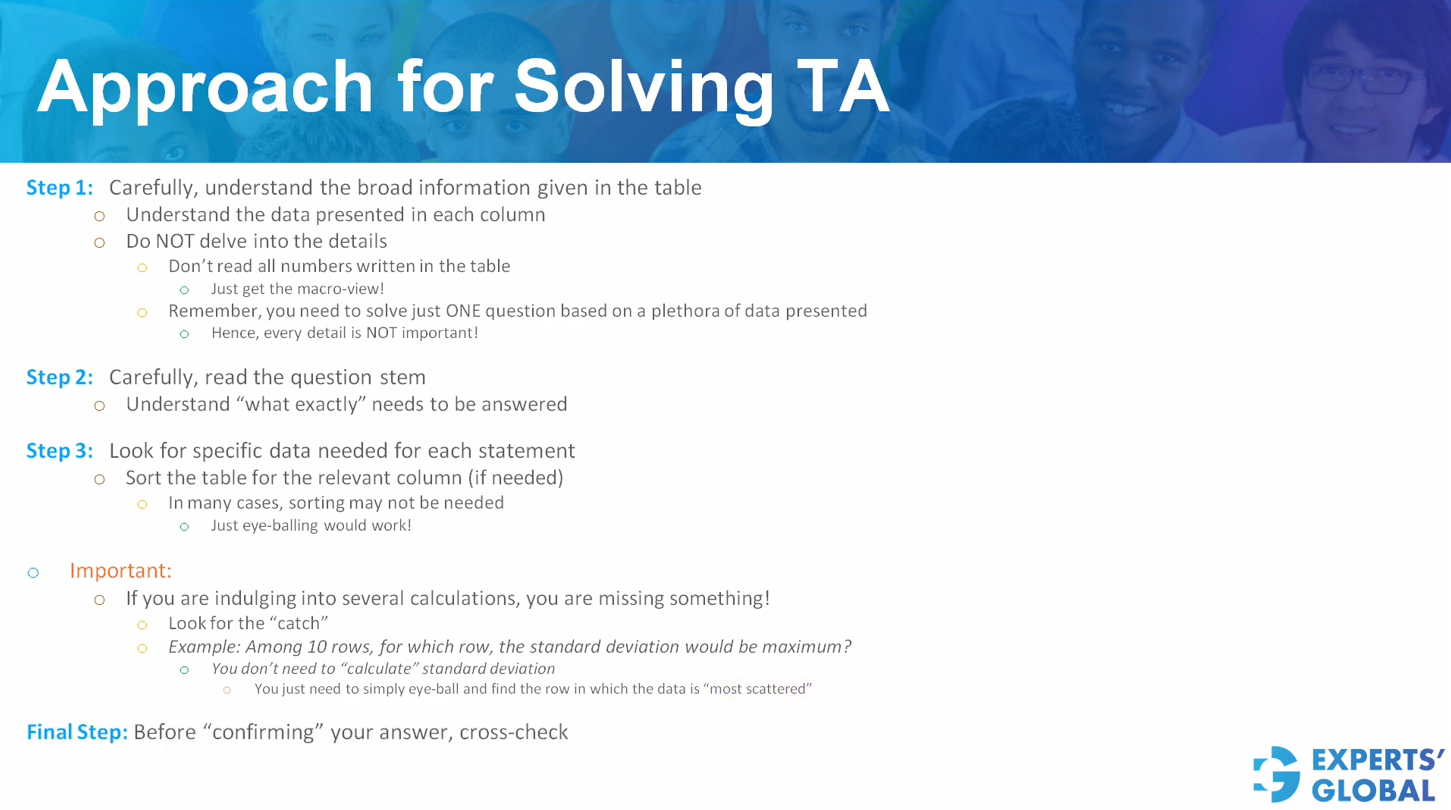Invest 30 seconds...
...for what may lead to a life altering association!
Help Line
- +91.8800.2828.00 (IND)
- 1030-1830 Hrs IST, Mon-Sat
- support@expertsglobal.com
...for what may lead to a life altering association!


Understand the table at a broad level, read the question stem carefully, locate only the specific data each statement needs, and sort the table if required. Then cross-check your reasoning before confirming your answer.

Table Analysis questions in the GMAT Data Insights section are designed to evaluate how effectively you can analyze structured data. Each question presents a detailed table containing multiple columns and rows, with extensive numerical information. The challenge lies in filtering out the noise and focusing on the data that directly impacts your answer.

Begin by studying the overall table structure. Read the title carefully and take note of the column headings. This helps you understand what type of data is being represented without getting lost in the numbers.
At this stage, do not read every figure in the table. You only need to form a macro-level understanding of what the data represents. The GMAT may provide vast tables, but remember, you are solving just one question. Not every column or row will be relevant. For instance, a table may contain sales figures across regions and product categories, but if the question pertains only to percentage growth, focus your attention there.

Correct Answer: Would help explain, Would help explain, Would help explain
Next, read the question stem closely. Understand exactly what is being asked before you look for numbers. Misinterpreting the question at this stage can waste time and lead you down the wrong path.
For example, the question may ask whether certain statements are true based on the given data. Each Table Analysis question usually presents three such statements. The goal is to determine whether each statement is “Yes”, “No”, or “Cannot Be Determined”. Reading the stem properly ensures that you know which columns and parameters are relevant.
Once you know what to find, move to the precise data that will help verify each statement. Look carefully at the relevant columns or rows. Decide whether sorting the table will help. The GMAT interface allows you to sort data by columns, which can simplify comparisons.
However, do not assume sorting is always necessary. In many cases, simply scanning the data — “eyeballing” — is enough, especially when the table has fewer rows. For instance, if you need to compare two categories such as “Hospitals” and “Restaurants,” sort by one of them only if it saves time. With practice, you will develop the intuition to know when sorting helps and when it is better to proceed visually.
A crucial insight in Table Analysis is that heavy calculations often indicate a wrong approach. While the GMAT provides a calculator for Data Insights, over-reliance on it can waste time. If you find yourself performing multiple complex calculations, pause and reconsider. There is likely a simpler way. For instance, if the question asks which row has the highest standard deviation, you do not need to calculate the exact values. Instead, observe which row has the most scattered numbers — this intuitive comparison reveals the answer far more efficiently. GMAT questions are built to reward logical recognition over mechanical effort. Precision is important, but efficiency is what truly defines success in this section.
Before submitting your response, take a final moment to cross-check your reasoning. Even simple oversights can lead to errors. Revisit the question stem, confirm that you interpreted the statements correctly, and verify that your answers align with the data. This quick check can prevent avoidable mistakes, especially in cases where multiple options appear close or when your conclusion depends on subtle differences in data.
The Table Analysis question type is not about speed-reading numbers; it is about intelligent filtering. It measures your ability to identify key relationships, ignore distractions, and apply logical reasoning under time constraints. The ability to stay composed while handling large data sets is a skill valued not only in the GMAT but also in real-world analytical decision-making.
True practice for table analysis grows only when you work on a software simulation that closely replicates the GMAT user interface. You need a platform that allows you to sort the table, interact with the data naturally, and use all the on-screen tools and functionalities provided on the real exam. Without this exact experience, it is very hard to prepare for what you will actually face on test day.
High quality data insights questions in general, and table analysis questions in particular, are not available in abundance. Among the limited, genuinely strong resources are the official practice materials released by GMAC and the Experts’ Global GMAT course.
Within the Experts’ Global GMAT online preparation course, every table analysis question appears on an exact GMAT-like user interface that includes all the real exam functionalities and tools. You work through more than 100 table analysis questions in quizzes and also take 15 full length GMAT practice tests that feature several table analysis items in the same spread and proportion in which they appear on the actual GMAT.